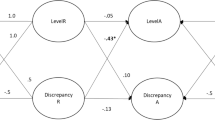Abstract
Twenty discordant couples and 20 nondiscordant couples completed a definition inventory of marriage-related concepts and semantic differential ratings of marriage-related and nonrelated concepts. Group performances on each of these instruments were compared. In addition, the relationship of actual similarity, perceived or assumed similarity, and prediction accuracy to spouses' marital satisfaction was investigated. Actual similarity of denotative and connotative meanings did not contribute to satisfaction. On the other hand, nondiscordant spouses significantly predicted their spouses' responses more accurately and perceived more similarity than discordant spouses. Therapeutic implications of the research are discussed.
Similar content being viewed by others
References
Baucom, D. H. (1982). A comparison of behavioral contracting and problem solving/communication training in behavioral marital therapy.Behavior Therapy, 13 163–174.
Broderick, J. E. (1981). A method for derivation of areas for assessment in marital relationships.American Journal of Family Therapy, 9 25–34.
Byrne, D., & Blaylock, B. (1963). Similarity and assumed similarity of attitudes between husbands and wives.Journal of Abnormal and Social Psychology, 67 636–640.
Christensen, L., & Wallace, L. (1976). Perceptual accuracy as a variable in marital adjustment.Journal of Sex and Marital Therapy, 2 130–136.
Corsini, R. J. (1956). Multiple predictors of marital happiness.Marriage and Family Living, 18 240–242.
Dymond, R. (1954). Interpersonal perception and marital happiness.Canadian Journal of Psychology, 8 154–171.
Ely, A. L., Guerney, B. G., & Stover, L. (1973). Efficacy of the training phase of conjugal therapy.Psychotherapy: Research, Theory and Practice, 10 201–207.
Geiss, S. K., & O'Leary, K. D. (1981). Therapist ratings of frequency and severity of marital problems: Implications for research.Journal of Marital and Family Therapy, 7 515–520.
Gottman, J., Notarius, C., Gonso, J., & Markman, H. (1976).A couple's guide to communication. Champaign, Illinois: Research Press.
Katz, M. (1965). Agreement of connotative meaning in marriage.Family Process, 4 64–74.
Kimmel, D., & Van der Veen, F. (1974). Factors of marital adjustment in Locke's Marital Adjustment Test.Journal of Marriage and the Family, 36 57–63.
Levinger, G., & Breedlove, J. (1966). Interpersonal attraction and agreement: A study of marriage partners.Journal of Personality and Social Psychology, 3 367–372.
Locke, H. J., & Wallace, K. M. (1959). Short marital-adjustment and prediction tests: Their reliability and validity.Marriage and Family Living, 21 251–255.
McNemar, Q. (1962).Psychological statistics (3rd. ed.). New York: Wiley.
Murstein, B. I. (1970). Stimulus-value-role: A theory of marital choice.Journal of Marriage and the Family, 32 465–481.
Murstein, B. I., & Beck, G. D. (1972). Person perception, marriage adjustment, and social desirability.Journal of Consulting and Clinical Psychology, 39 296–403.
Newmark, C. S., Woody, G., & Ziff, D. (1977). Understanding and similarity in relation to marital satisfaction.Journal of Clinical Psychology, 33 83–86.
O'Leary, K. D., & Turkewitz, H. (1978). Marital therapy from a behavioral perspective. In T. J. Paolino & B. S. McCrady (Eds.),Marriage and marital therapy. New York: Brunner/Mazel.
Oltmanns, T. F., Broderick, J., & O'Leary, K. D. (1977). Marital adjustment and the efficacy of behavior therapy with children.Journal of Consulting and Clinical Psychology, 45 724–729.
Osgood, C. E. (1952). The nature and measurement of meaning.Psychological Bulletin, 49 197–237.
Preston, M. G., Peltz, W. L., Mudd, E. H., & Froscher, H. B. (1952). Impressions of personality as a function of marital discord.Journal of Abnormal and Social Psychology, 47 326–336.
Sears, R. R. (1977). Sources of life satisfactions of the Terman gifted men.American Psychologist, 32 119–128.
Turkewitz, H., & O'Leary, K. D. (1981). A comparative study of behavioral marital therapy and communication therapy.Journal of Marital and Family Therapy, 7 159–169.
Author information
Authors and Affiliations
Rights and permissions
About this article
Cite this article
Arias, I., O'Leary, K.D. Semantic and perceptual discrepancies in discordant and nondiscordant marriages. Cogn Ther Res 9, 51–60 (1985). https://doi.org/10.1007/BF01178750
Issue Date:
DOI: https://doi.org/10.1007/BF01178750




